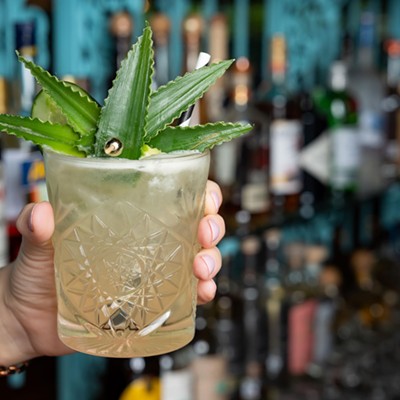'Fish heads are a delicacy all over China," said my dinner companion, Tony. Chinese by descent, Tony devoured about two-thirds of our spicy fish head plate, a Hunan specialty, all by himself. "The eyes -- the slimy parts -- they are the best," he explained as he contentedly ate his way through the dish, slurping and sucking on parts that appeared to be just bone and skin while leaving all the fish flesh, including the plump, silky collar, to me.
We were dining at Spicy Hunan, a small hole-in-the-wall in the back of Dun Huang Plaza, currently the largest retail condo development on Bellaire Boulevard in Chinatown. It was a chilly winter night, the air so cold that the mere act of breathing caused puffs of condensation to form.
Spicy Hunan, which opened approximately four months ago, is located in the far left corner of the development, sandwiched unremarkably among several other restaurants of the same size, two of which had also opened recently. Two doors down to the left, Sichuan Noodles, which opened about a month ago, was lightly occupied with just two tables. To the right, underneath a bright red "Grand Opening" banner, the attractively decorated Golden Panda sat virtually empty.
Brightly lit from within, the bustling scene through the window at Spicy Hunan could have been anywhere in China. Asian patrons filled every single table in the small rectangular room, wielding chopsticks over bowls of rice as they dined, slightly hunched, on plates served family style.
In Chinatown, good restaurants quickly separate themselves from the rest, thanks to word of mouth. That's how we came to be at Spicy Hunan: The word on the street, as evidenced by the fact that it's packed nightly, is that the food is good and authentic.
Hunan cuisine is one of the eight great culinary traditions of China. Originating in western Hunan province, the food is characterized by dry spiciness, which is to be distinguished from the more well-known food of Sichuan, which is known for being spicy and numbing.
One of the region's best-known dishes is a spicy fish head, which Spicy Hunan uses not just as a logo (a picture of the fish head is on the restaurant's sign) but as an advertisement of this specialty. The dish itself is spectacularly plated on a large 24-inch round platter, and every time it comes from the kitchen, it causes heads to turn. It also takes some time to prepare, so if you plan to indulge in this Chinese delicacy, it's best to order it as soon as you arrive.
The dish is not for everyone. The evening we were there, our server informed us that the restaurant had only medium-size portions left (Spicy Hunan offers small, large and medium orders), forcing us to order a larger size than we wanted. What came to our table, though impressive visually, was relished more for its novelty than as something we'd knowingly order again.
From afar, the plating made it appear as though we'd be getting one massive foot-long fish head. Actually, the dish was composed of three medium-size fish heads placed so that the mouths of the fish pointed toward the middle of the plate.
Topped with a thick coating of chile-seasoned tomato sauce and a generous amount of cilantro, it looked frighteningly spicy. As it turned out, the spice was so mild it was almost nonexistent, the flavors resembling those one might find in a Mediterranean dish, like a mild Italian tomato sauce tinged with soy sauce and chile pepper flakes.
It wasn't that the dish was bad. It was just kind of lackluster on the palate. It was also extremely difficult to eat. The slippery heads would often slide through your chopsticks and fall back onto the plate as you tried to find the meat on the bones, causing little splashes of sauce to spray all over. We picked through what little flesh we could fairly quickly, so that all that was left was skin and bones, something that only a Chinese person (like our friend Tony) who'd grown up with it might enjoy.
Better to get the steamed sole filet over soft tofu. Served with the same pickled chile sauce and cilantro and plated beautifully on the same large round platter, not only was the filet a good 40 percent cheaper than the fish head dish, it was so much more memorable. Soft and silky and incredibly airy, like sheets of a savory steamed custard, each bite of pillowy tofu next to the plump, firm pieces of sole was unique and noteworthy -- and completely unforgettable even though the dish was oversalted the night we had it.
In fact, during that visit, pronounced saltiness seemed be the overriding theme for several of the dishes we tried, including an iron pot special of terrific-sounding bone-in duck with 4 season chile peppers, a smoked beef with dried beans and chile peppers, and smoked pork with dry bean curd. The seasoning and flavorings across the three dishes were very similar as well, so that everything started to taste the same. When we advised our server, she told us to tell the kitchen to use less salt on our next visit.






